 |
LTI611S- LAND TRANSPORT SAFETY AND INFRASTRUCTURE CONSIDERATIONS- 1ST OPP- JUNE 2024 |
 |
1 Page 1 |
▲back to top |
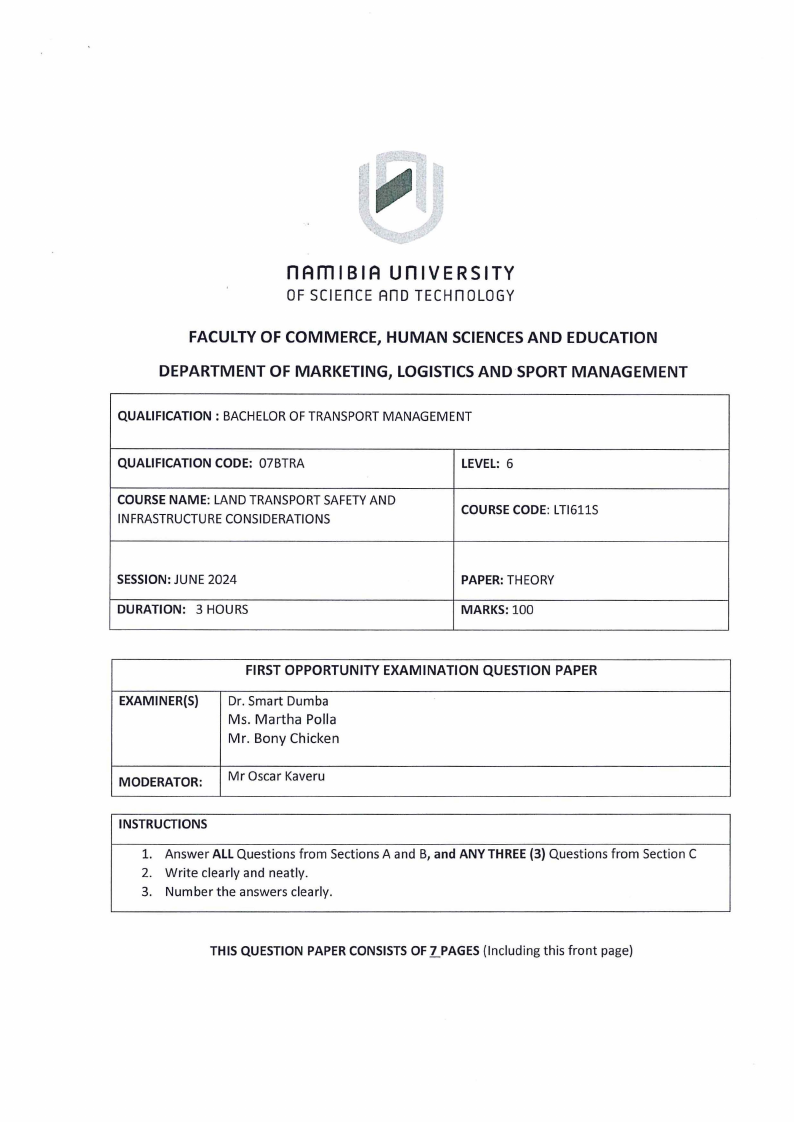
n Am I BI A u n IVER s I TY
OF SCIEnCE
TECHnOLOGY
FACULTY OF COMMERCE, HUMAN SCIENCESAND EDUCATION
DEPARTMENT OF MARKETING, LOGISTICS AND SPORT MANAGEMENT
QUALIFICATION: BACHELOROF TRANSPORT MANAGEMENT
QUALIFICATIONCODE: 07BTRA
COURSENAME: LAND TRANSPORT SAFETYAND
INFRASTRUCTURECONSIDERATIONS
LEVEL: 6
COURSECODE: LTl611S
SESSION:JUNE 2024
DURATION: 3 HOURS
PAPER:THEORY
MARKS: 100
EXAMINER{S)
FIRST OPPORTUNITY EXAMINATION QUESTION PAPER
Dr. Smart Dumba
Ms. Martha Polla
Mr. Bony Chicken
MODERATOR: Mr Oscar Kaveru
INSTRUCTIONS
1. Answer ALLQuestions from Sections A and B, and ANY THREE(3) Questions from Section C
2. Write clearly and neatly.
3. Number the answers clearly.
THIS QUESTION PAPERCONSISTSOFI_PAGES{Including this front page)
 |
2 Page 2 |
▲back to top |
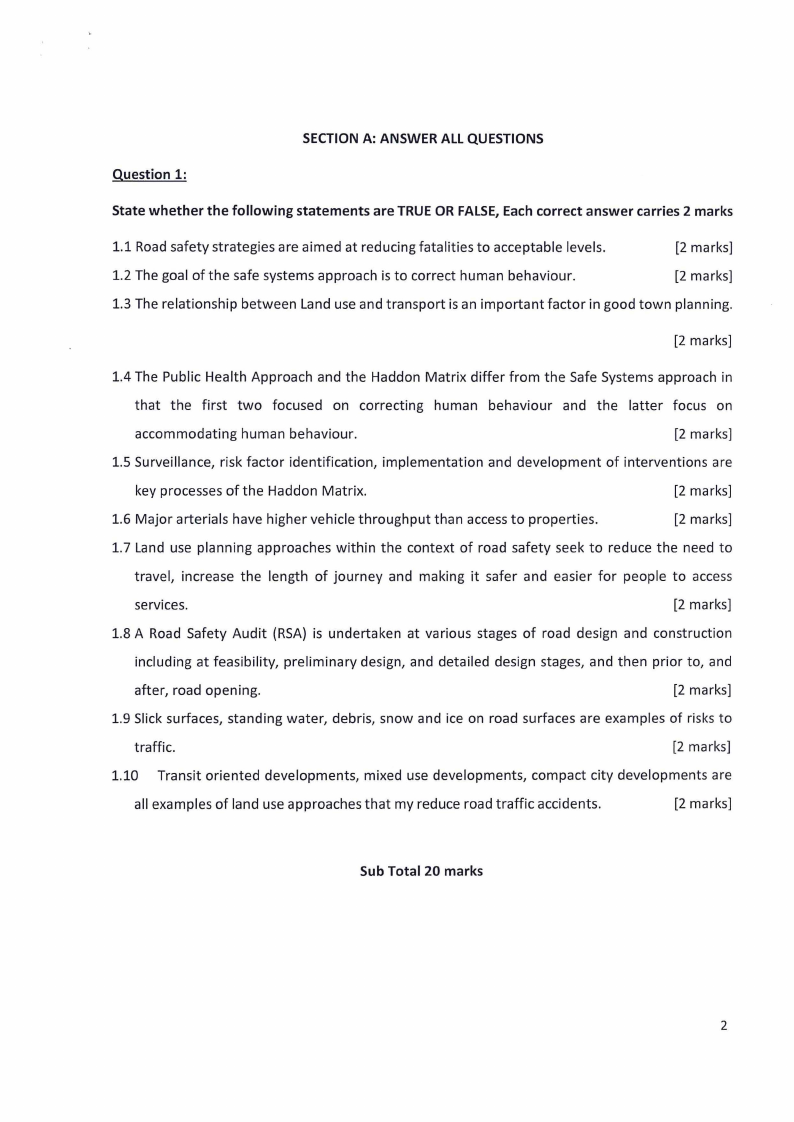
SECTION A: ANSWER ALL QUESTIONS
Question 1:
State whether the following statements are TRUE OR FALSE,Each correct answer carries 2 marks
1.1 Road safety strategies are aimed at reducing fatalities to acceptable levels.
[2 marks]
1.2 The goal of the safe systems approach is to correct human behaviour.
[2 marks]
1.3 The relationship between Land use and transport is an important factor in good town planning.
[2 marks]
1.4 The Public Health Approach and the Haddon Matrix differ from the Safe Systems approach in
that the first two focused on correcting human behaviour and the latter focus on
accommodating human behaviour.
[2 marks]
1.5 Surveillance, risk factor identification, implementation and development of interventions are
key processes of the Haddon Matrix.
[2 marks]
1.6 Major arterials have higher vehicle throughput than access to properties.
[2 marks]
1.7 Land use planning approaches within the context of road safety seek to reduce the need to
travel, increase the length of journey and making it safer and easier for people to access
services.
[2 marks]
1.8 A Road Safety Audit (RSA} is undertaken at various stages of road design and construction
including at feasibility, preliminary design, and detailed design stages, and then prior to, and
after, road opening.
[2 marks]
1.9 Slick surfaces, standing water, debris, snow and ice on road surfaces are examples of risks to
traffic.
[2 marks]
1.10 Transit oriented developments, mixed use developments, compact city developments are
all examples of land use approaches that my reduce road traffic accidents.
[2 marks]
Sub Total 20 marks
2
 |
3 Page 3 |
▲back to top |
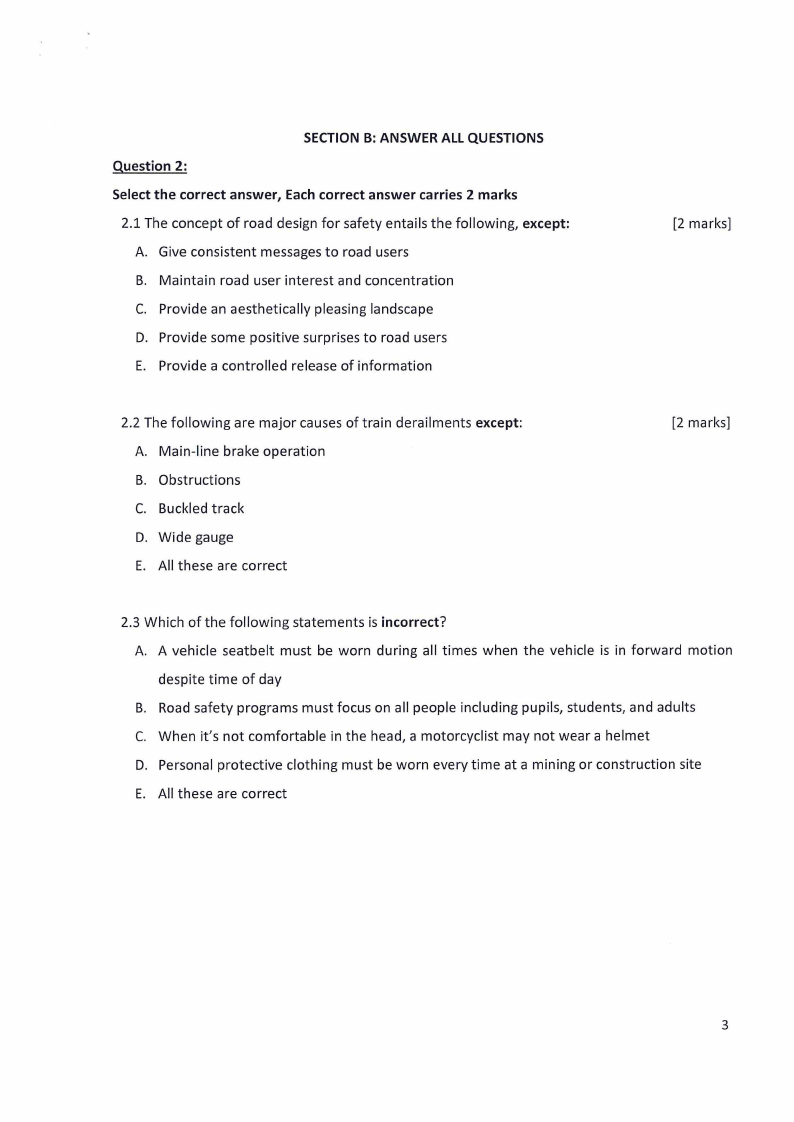
SECTION B: ANSWER ALL QUESTIONS
Question 2:
Select the correct answer, Each correct answer carries 2 marks
2.1 The concept of road design for safety entails the following, except:
A. Give consistent messages to road users
B. Maintain road user interest and concentration
C. Provide an aesthetically pleasing landscape
D. Provide some positive surprises to road users
E. Provide a controlled release of information
[2 marks]
2.2 The following are major causes of train derailments except:
A. Main-line brake operation
B. Obstructions
C. Buckled track
D. Wide gauge
E. All these are correct
[2 marks]
2.3 Which of the following statements is incorrect?
A. A vehicle seatbelt must be worn during all times when the vehicle is in forward motion
despite time of day
B. Road safety programs must focus on all people including pupils, students, and adults
C. When it's not comfortable in the head, a motorcyclist may not wear a helmet
D. Personal protective clothing must be worn every time at a mining or construction site
E. All these are correct
3
 |
4 Page 4 |
▲back to top |
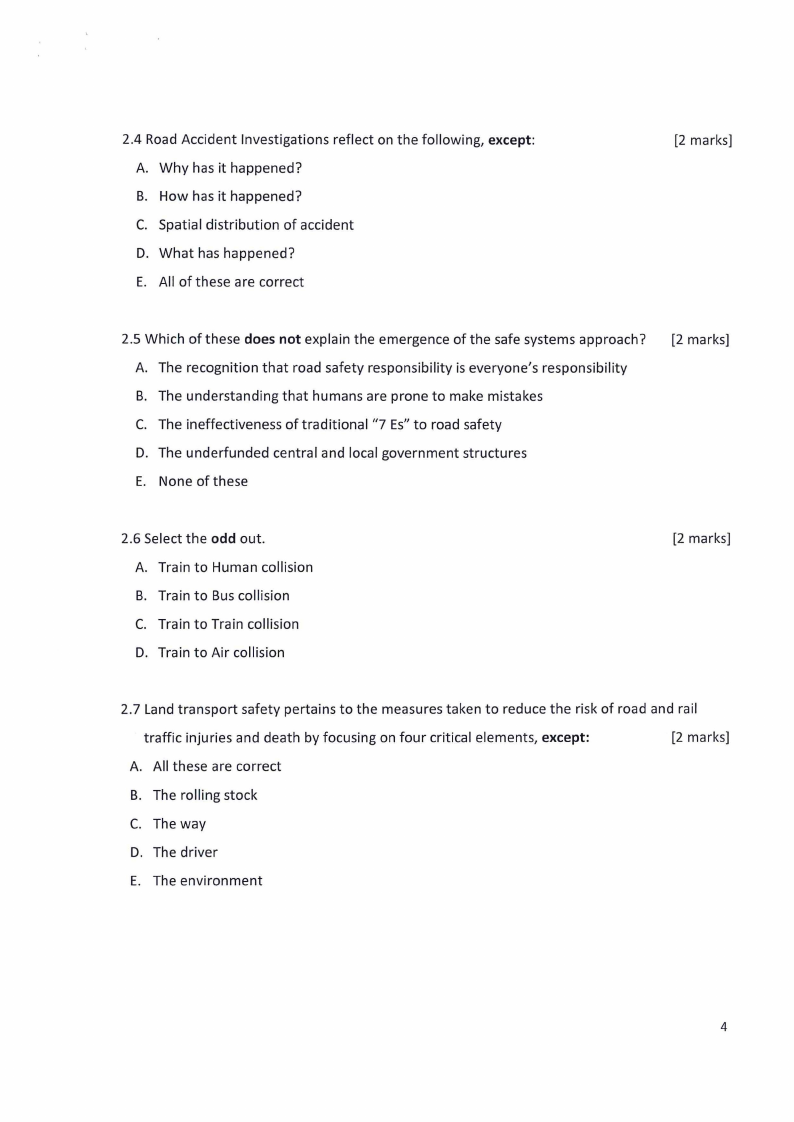
2.4 Road Accident Investigations reflect on the following, except:
A. Why has it happened?
B. How has it happened?
C. Spatial distribution of accident
D. What has happened?
E. All of these are correct
[2 marks]
2.5 Which of these does not explain the emergence of the safe systems approach?
A. The recognition that road safety responsibility is everyone's responsibility
B. The understanding that humans are prone to make mistakes
C. The ineffectiveness of traditional "7 Es" to road safety
D. The underfunded central and local government structures
E. None of these
[2 marks]
2.6 Select the odd out.
A. Train to Human collision
B. Train to Bus collision
C. Train to Train collision
D. Train to Air collision
[2 marks]
2.7 Land transport safety pertains to the measures taken to reduce the risk of road and rail
traffic injuries and death by focusing on four critical elements, except:
[2 marks]
A. All these are correct
B. The rolling stock
C. The way
D. The driver
E. The environment
4
 |
5 Page 5 |
▲back to top |
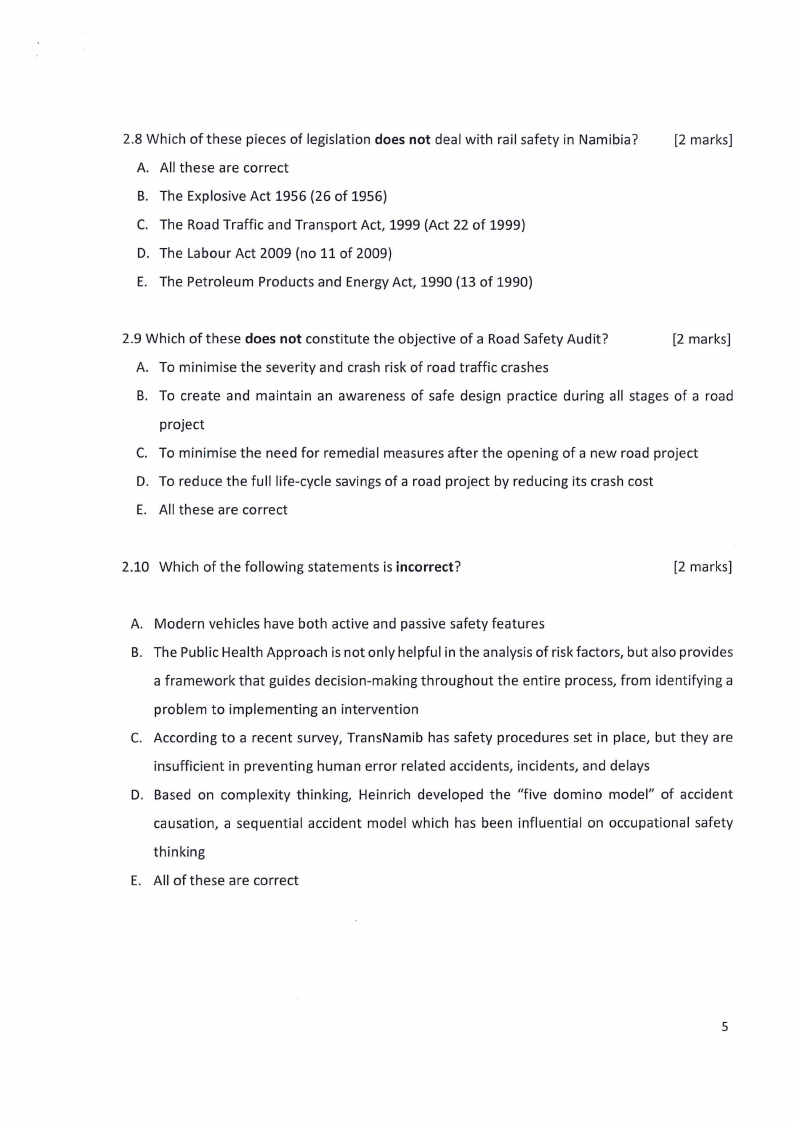
2.8 Which of these pieces of legislation does not deal with rail safety in Namibia?
A. All these are correct
B. The Explosive Act 1956 (26 of 1956)
C. The Road Traffic and Transport Act, 1999 (Act 22 of 1999)
D. The Labour Act 2009 (no 11 of 2009)
E. The Petroleum Products and Energy Act, 1990 (13 of 1990)
[2 marks]
2.9 Which of these does not constitute the objective of a Road Safety Audit?
[2 marks]
A. To minimise the severity and crash risk of road traffic crashes
B. To create and maintain an awareness of safe design practice during all stages of a road
project
C. To minimise the need for remedial measures after the opening of a new road project
D. To reduce the full life-cycle savings of a road project by reducing its crash cost
E. All these are correct
2.10 Which of the following statements is incorrect?
[2 marks]
A. Modern vehicles have both active and passive safety features
B. The Public Health Approach is not only helpful in the analysis of risk factors, but also provides
a framework that guides decision-making throughout the entire process, from identifying a
problem to implementing an intervention
C. According to a recent survey, TransNamib has safety procedures set in place, but they are
insufficient in preventing human error related accidents, incidents, and delays
D. Based on complexity thinking, Heinrich developed the "five domino model" of accident
causation, a sequential accident model which has been influential on occupational safety
thinking
E. All of these are correct
5
 |
6 Page 6 |
▲back to top |
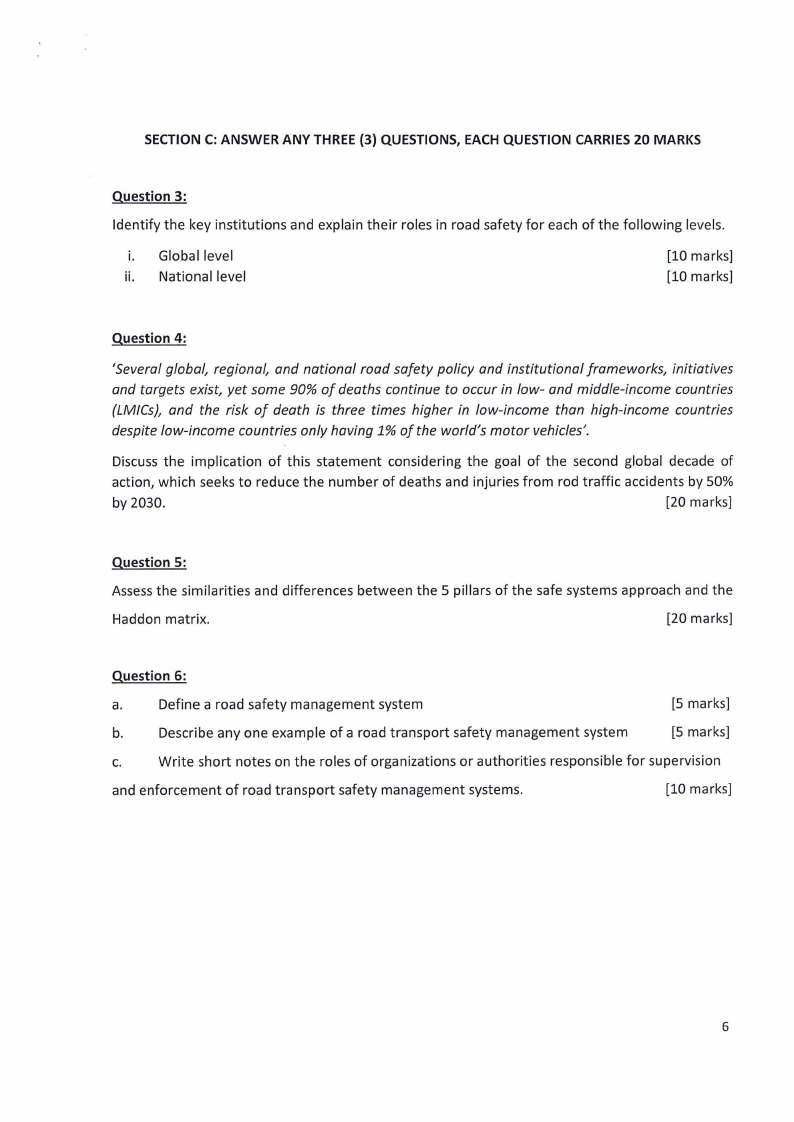
SECTION C: ANSWER ANY THREE (3) QUESTIONS, EACH QUESTION CARRIES 20 MARKS
Question 3:
Identify the key institutions and explain their roles in road safety for each of the following levels.
i. Global level
ii. National level
[10 marks]
[10 marks]
Question 4:
'Several global, regional, and national road safety policy and institutional frameworks, initiatives
and targets exist, yet some 90% of deaths continue to occur in low- and middle-income countries
(LM/Cs},and the risk of death is three times higher in !ow-income than high-income countries
despite low-income countries only having 1% of the world's motor vehicles'.
Discuss the implication of this statement considering the goal of the second global decade of
action, which seeks to reduce the number of deaths and injuries from rod traffic accidents by 50%
by 2030.
[20 marks]
Question 5:
Assessthe similarities and differences between the 5 pillars of the safe systems approach and the
Haddon matrix.
[20 marks]
Question 6:
a.
Define a road safety management system
[5 marks]
b.
Describe any one example of a road transport safety management system
[S marks]
c.
Write short notes on the roles of organizations or authorities responsible for supervision
and enforcement of road transport safety management systems.
[10 marks]
6
 |
7 Page 7 |
▲back to top |
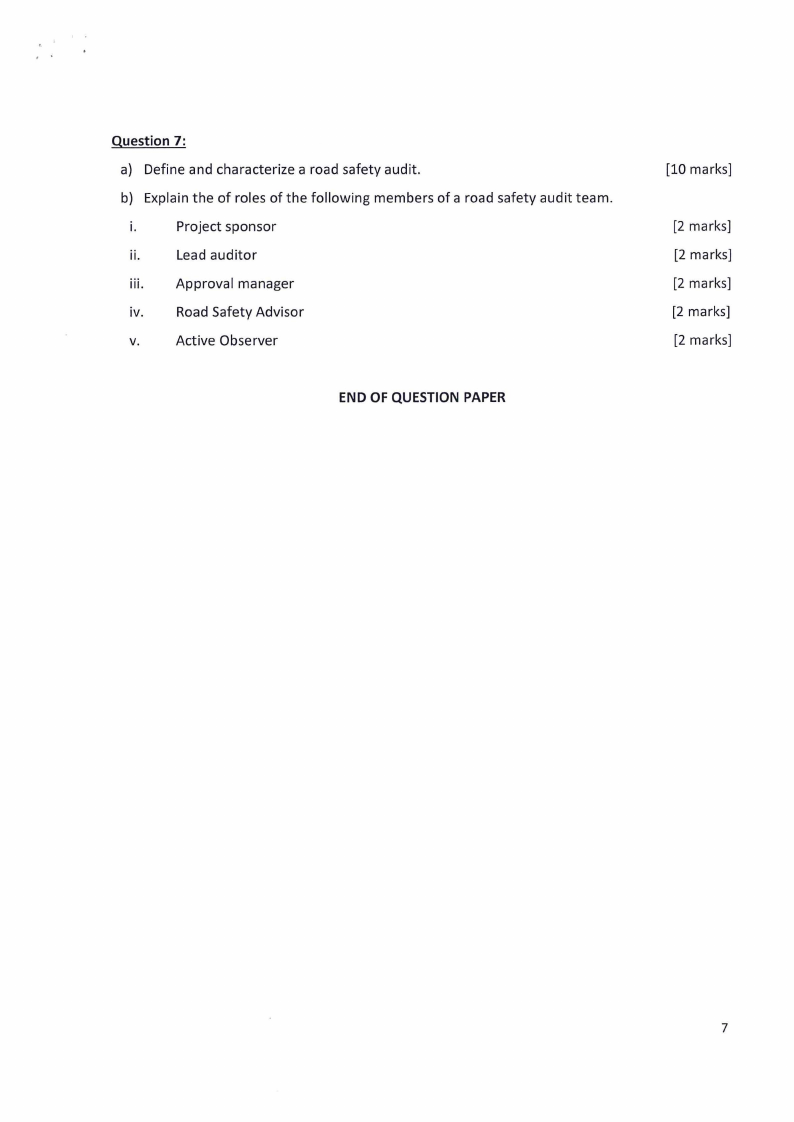
Question 7:
a) Define and characterize a road safety audit.
b) Explain the of roles of the following members of a road safety audit team.
i.
Project sponsor
ii.
Lead auditor
iii. Approval manager
iv. Road Safety Advisor
V.
Active Observer
END OF QUESTION PAPER
[10 marks]
[2 marks]
[2 marks]
[2 marks]
[2 marks]
[2 marks]
7





